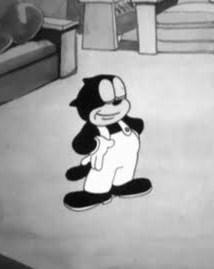
Porky in Wackyland is a 1938 Warner Bros. Looney Tunes animated short film, directed by Bob Clampett. The short was released on September 24, 1938, and stars Porky Pig venturing out to find the last do-do bird, which he finds in Wackyland, a land that makes no sense located in Darkest Africa.

Fresh Hare is a Warner Bros. Merrie Melodies cartoon directed by Friz Freleng, written by Michael Maltese, and produced by Leon Schlesinger. It was released to theatres on August 22, 1942.

Beans the Cat is an animated cartoon character in the Warner Bros. Cartoons series of cartoons from 1935–1936. Beans was the third Warner Bros cartoon character star after Bosko and Buddy. He was voiced by Billy Bletcher. He was created by director Friz Freleng. The character was featured in nine cartoons made in 1935 and 1936.

Bugs Bunny Gets the Boid is a 1942 Merrie Melodies cartoon, directed by Bob Clampett, produced by Leon Schlesinger, and released to theatres by Warner Bros. Pictures. It marks the first appearance of Beaky Buzzard in a Warner Bros. short.
The Squawkin' Hawk is a 1942 Merrie Melodies cartoon directed by Chuck Jones. The short was released on August 8, 1942, and is the first to star the young Henery Hawk. It was animated by Phil Monroe and was written by Michael Maltese, the latter being his first collaboration with Jones.

The Heckling Hare is a Merrie Melodies cartoon, released on July 5, 1941, and featuring Bugs Bunny and a dopey dog named Willoughby. The cartoon was directed by Tex Avery, written by Michael Maltese, animated by soon-to-be director Robert McKimson, and with musical direction by Carl W. Stalling. In a style that was becoming typical of the Bugs character, he easily outwitted and tormented his antagonist through the short, his only concern being what to do next to the dog.

I Love to Singa is a 1936 Warner Bros. Merrie Melodies animated cartoon directed by Tex Avery. The short was released on July 18, 1936.

Sunday Go to Meetin' Time is a 1936 Warner Bros. Merrie Melodies cartoon directed by Friz Freleng. The short was released on August 8, 1936. The name of the short comes from the colloquial adjective "sunday-go-to-meeting", describing something appropriate for church or otherwise presentable.

Hollywood Steps Out is a 1941 short Merrie Melodies cartoon by Warner Bros., directed by Tex Avery. The short was released on May 24, 1941.

Cheese Chasers is a 1951 Warner Bros. Merrie Melodies cartoon directed by Chuck Jones and written by Michael Maltese. The cartoon was released on August 25, 1951 and stars Hubie and Bertie, with Claude Cat.

A Pest in the House is a Merrie Melodies animated short film released on August 2, 1947. It is directed by Chuck Jones and stars the characters of Daffy Duck and Elmer Fudd.
The Fella with a Fiddle is a 1937 Warner Bros. Merrie Melodies cartoon directed by Friz Freleng. The short was released on March 27, 1937.

Porky's Pooch is a 1941 Warner Bros. Looney Tunes cartoon directed by Bob Clampett. The short was released on December 27, 1941, and stars Porky Pig.
The character that would evolve into Bugs Bunny appeared in four cartoon shorts before his first official appearance in Tex Avery's A Wild Hare. While this early version is commonly referred to as "Happy Rabbit", animation historian David Gerstein disputes this, saying that the only usage of the term was from Mel Blanc himself; the name "Bugs Bunny" was used as early as April 1938, from a model sheet made by Charles Thorson which was used for the short Hare-um Scare-um. Bugs was also mentioned by name from an August 1939 review of the short in the Motion Picture Herald.
Fair and Worm-er is a 1946 Warner Bros. Merrie Melodies cartoon directed by Chuck Jones. The short was released on September 28, 1946.

Room and Bird is a 1951 Warner Bros. Merrie Melodies animated short directed by Friz Freleng. The short was released on June 2, 1951, and stars Tweety and Sylvester.

The Early Bird Dood It! is a 1942 MGM cartoon directed by Tex Avery and produced by Fred Quimby. The composer of this cartoon was Scott Bradley.

Birdy and the Beast is a 1944 Warner Bros. Merrie Melodies directed by Bob Clampett. The short was released on August 19, 1944, and stars Tweety.

Looney Tunes Platinum Collection: Volume 2 is a Blu-ray and DVD box set by Warner Home Video released on October 16, 2012. It contains 50 Looney Tunes and Merrie Melodies cartoons and numerous supplements. Disc 3 is exclusive to the Blu-ray version of the set. Unlike Volume 1, which was released in a digibook, Volume 2 was released in a standard 1 movie case. This release was followed by Looney Tunes Platinum Collection: Volume 3
The Miller's Daughter is a 1934 Warner Bros. Merrie Melodies cartoon directed by Friz Freleng. The short was released on October 13, 1934.















